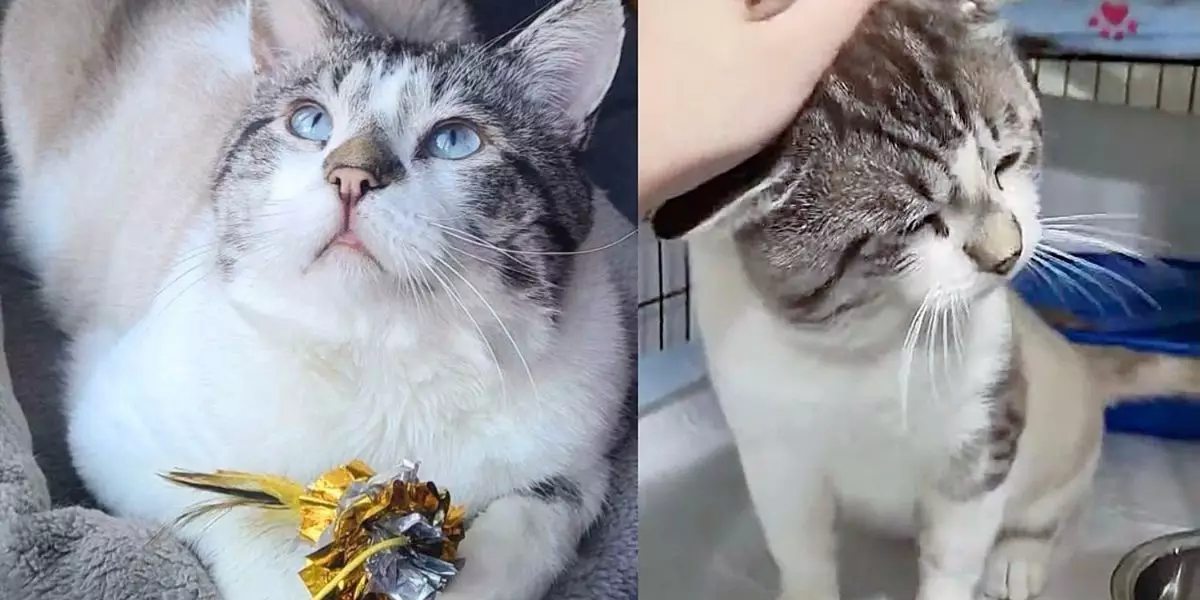In the eyes of many, cats are often perceived as independent creatures capable of fending for themselves. However, the story of Trafalgar, a once-lost cat, illustrates the stark reality that not all felines can navigate the harshness of life outdoors. Found wandering in a feral cat colony, Trafalgar was a striking blue-eyed cat that had been abandoned and left to fend for himself. Encountering aggression from other tomcats and struggling to access food, it was evident that his days outside were numbered. This particular case highlights not just the vulnerability of stray animals but also the vital role that rescue organizations play in their salvation.
The initial encounter with dedicated volunteers from Chatons Orphelins Montreal became the turning point in Trafalgar’s life. Recognizing his unfortunate circumstances, the rescuers were determined to bring him into a safer environment. Upon their intervention, Trafalgar was characterized not merely by his physical attributes, but also by the emotional scars of his past. His initial behavior—hiding and appearing anxious—was a reflection of his previous struggles, showcasing the psychological impact that abandonment can have on animals.
Once taken into foster care, a profound transformation began to unfold. The gentle giant named Trafalgar initially seemed unsure of his new surroundings, displaying signs of nervousness typical in animals that have faced trauma. Nevertheless, the power of a loving and safe home quickly began to work its magic. Trafalgar discovered comfort in his new environment; nestled in blankets and surrounded by kindness, he slowly emerged from his shell and began to express his affectionate nature.
Visitors and even his foster family soon learned about his overwhelming sweetness and gentle demeanor. Despite his large size, Trafalgar’s heart was even bigger—filled with an innate capacity for love and companionship. His fondness for human interaction grew steadily, highlighting the innate desire for connection inherent in many animals. This aspect of his personality exemplifies the necessity for socialization, even in pets that have endured hardship.
Trafalgar quickly evolved from a once-timid cat to an affectionate companion, eagerly greeting his humans with enthusiastic bear hugs at the door. His charming antics, such as curiously inspecting the refrigerator and playfully engaging with feather toys, brought joy and laughter to his new household. These quirky characteristics served not only as a source of entertainment but also reinforced the bond he increasingly developed with his foster family.
A striking example of his playful nature was observed during playtime, where the sight of fluttering feathers would send him running with delightful excitement. This enjoyment of play is crucial as it demonstrates that, despite his difficult past, Trafalgar was still able to embrace joy and spontaneity—a testament to the resilience commonly found in animals that have undergone significant trauma.
The emotional bond that Trafalgar established with his foster family is a profound reminder of how crucial interaction and affection are for pets navigating the after-effects of abandonment. His reliance on his humans for companionship and affection transformed him from a cautious stray into a loving member of the family. These interactions allowed Trafalgar to exhibit some endearing behaviors characteristic of dogs, such as his yearning to be wherever his humans were, and reflecting how different species can share similar emotional needs.
As seasons changed, Trafalgar was rescued just in time to avoid the dangers posed by cold weather, a poignant illustration of the life-or-death importance of timely intervention by rescue organizations. Without such efforts, many animals face perilous conditions that threaten their survival, underscoring the ongoing need for support and funding for animal welfare initiatives.
Ultimately, Trafalgar’s journey showcases the power of love, compassion, and commitment in transforming a life. Thanks to the dedication of volunteers and the willingness of foster families, Trafalgar has transitioned from a life fraught with suffering to one filled with warmth and affection. His story serves not just as an inspiring tale of rescue but also as a call to action for animal lovers to continue supporting rescue efforts that provide homeless animals with the chance for a brighter future.
As Trafalgar continues to thrive in his loving home, he represents both the potential for recovery and the lasting impact of kindness extended by those who care for animals in need. The joy he brings to his new family is a poignant reminder of the immeasurable value that pets provide in our lives.
